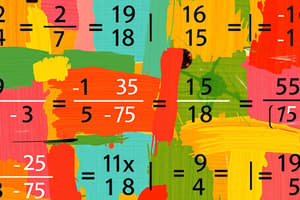Podcast
Questions and Answers
What does it mean to simplify a fraction?
What does it mean to simplify a fraction?
- To find the smallest possible form by dividing both the numerator and denominator by their greatest common divisor (correct)
- To add the numerator and denominator together
- To convert the fraction into a mixed number
- To multiply the numerator and denominator by the same number
Which of the following is a correct way to simplify the fraction 10/15?
Which of the following is a correct way to simplify the fraction 10/15?
- 2/3 (correct)
- 6/9
- 4/7
- 5/8
Why is it important to simplify fractions?
Why is it important to simplify fractions?
- To make fractions more complex
- To increase the value of the fractions
- To make the fractions look larger
- To prevent confusion and errors in calculations (correct)
When multiplying fractions, what do you do with the numerators and denominators?
When multiplying fractions, what do you do with the numerators and denominators?
What is the result of multiplying 2/3 by 4/9?
What is the result of multiplying 2/3 by 4/9?
How would you simplify the fraction 16/24?
How would you simplify the fraction 16/24?
What is the first step in adding fractions?
What is the first step in adding fractions?
In adding fractions, what does the common denominator represent?
In adding fractions, what does the common denominator represent?
When adding fractions, why is it important to simplify them before performing the operation?
When adding fractions, why is it important to simplify them before performing the operation?
What is the result of multiplying 2/5 by 3/3?
What is the result of multiplying 2/5 by 3/3?
When adding fractions, what should be done once the numerators are added?
When adding fractions, what should be done once the numerators are added?
Why is finding a common denominator important when adding fractions?
Why is finding a common denominator important when adding fractions?
Flashcards are hidden until you start studying
Study Notes
Simplifying Fractions
Fractions are a way to represent portions of a whole, often in the form of a numerator divided by a denominator, as a/b. When dealing with fractions, simplifying them means finding their smallest possible form, which is also known as reducing or rationalizing them.
To simplify a fraction, look for factors that can be divided evenly into both the numerator and the denominator. For example, consider the fraction 7/14. We can see that 7 is a multiple of 2 and 4, and 14 is also a multiple of 2 and 7. By dividing both the numerator and the denominator by the greatest common divisor (GCD), which in this case is 2, we get 7/14 → 7/2 × 1/7 → 1/2.
Simplifying fractions is essential because it helps prevent confusion and errors when performing calculations with them. It also ensures that the fractions are being represented in the smallest possible form, which makes it easier to interpret their meaning and perform arithmetic operations.
Multiplying Fractions
Multiplying fractions involves multiplying both the numerator and the denominator of each fraction. To do this, simply find the product of the numerators and the product of the denominators, then use that result as the new numerator and denominator. For example, 3/5 × 4/7 = 12/35.
Multiplying fractions is important because it allows us to perform operations on fractions that can be used to find the product of two or more fractions, or to find the inverse of a fraction (its reciprocal).
Adding Fractions
Adding fractions involves finding a common denominator and then adding the numerators while keeping the denominator the same. The common denominator is the least common multiple (LCM) of the denominators being added. For example, to add 2/5 and 1/3, we find the LCM of 5 and 3, which is 15. Then we write each fraction as a multiple of the LCM: 2/5 × 3/3 = 6/15 and 1/3 × 5/5 = 5/15. Now, we add the numerators: 6/15 + 5/15 = 11/15.
Adding fractions is essential because it allows us to combine fractions that represent portions of the same whole or to find the total portion represented by multiple fractions. This operation is often used when solving problems that require combining fractions, such as finding the sum of fractions, or performing operations on fractions to find a result expressed in fraction form.
Remember, when performing arithmetic operations on fractions, it's important to simplify them before performing the operation, and then simplify the result of the operation. This will help ensure that the fractions are being used and interpreted accurately. Practicing these skills will help strengthen your ability to work with fractions in a variety of situations.
Studying That Suits You
Use AI to generate personalized quizzes and flashcards to suit your learning preferences.




